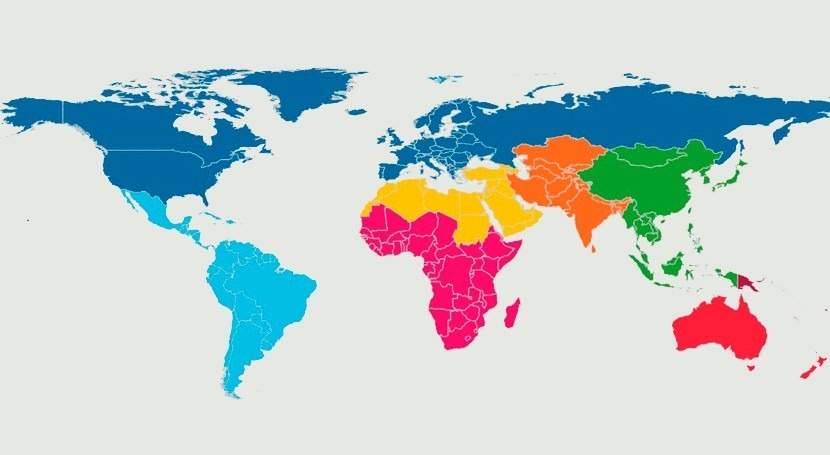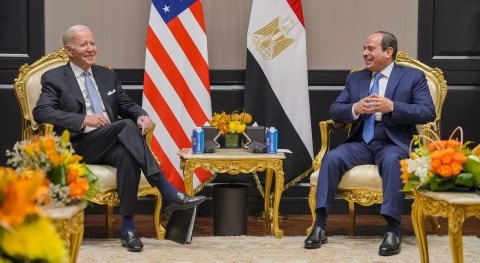SDG 6 seeks to ensure access to water and sanitation for all, focusing on sustainable water resource management. Even though there is enough freshwater in our planet, it is not fairly distributed. This inequality, together with poor water quality and inadequate sanitation in some places of the globe, have an impact on water security and livelihoods.
Assessing the quality of water, the population that has access to safe drinking water or sanitation services or the proportion of waste water that is safely treated are some of the indicators the UN has established to track progress towards SDG 6. In this regard, according to country data compiled and verified by the United Nations agencies responsible over the past few years (2017), overall we know the following about some of the targets:
- Drinking water: 71% of the world's population use a safely managed drinking water service (SDG indicator 6.1.1), defined as an improved source of drinking water that is located on the premises and available when needed, and free of faecal and priority chemical contamination.
- Sanitation: 45% of the world's population use a safely managed sanitation system (SDG indicator 6.2.1a), defined as an improved sanitation facility which is not shared with other households and where excreta are safely disposed in situ or transported and treated off-site.
- Hygiene: 60% of the world's population have access to a basic handwashing facility (SDG indicator 6.2.1b) with water and soap.
- Water management: 49% is the degree of implementation of integrated water resources management (IWRM) at the global level (SDG indicator 6.5.1) based on reporting from 172 countries.
- Transboundary waters: 59% of the transboundary basin area has an operational arrangement for water cooperation (SDG indicator 6.5.2).
- International cooperation: 8.8 b$ is the global amount of water- and sanitation-related official development assistance disbursed in 2017 (SDG indicator 6.a.1).
Water and sanitation in Europe and North America
The data compilation provided by the UN shows that 95% of the population in Europe and North America use drinking water services. In countries like the United States or Sweden it goes up to 100%.
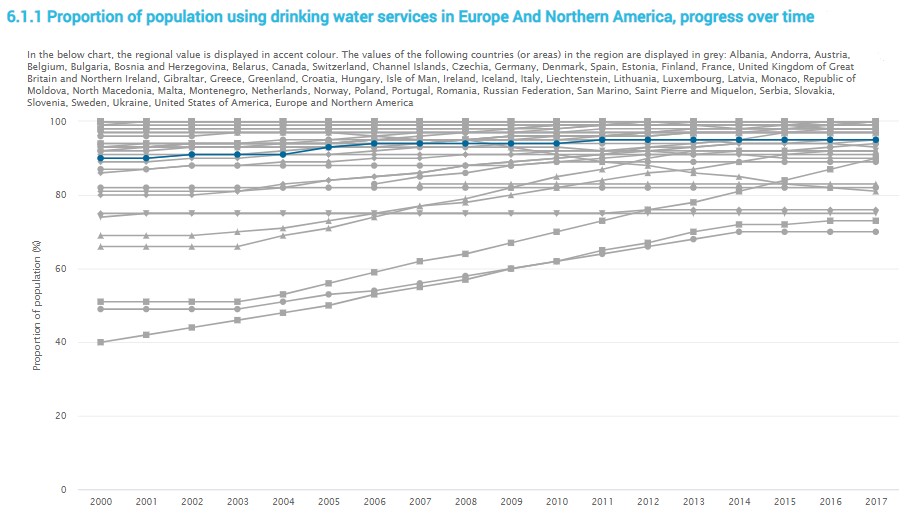
In terms of the proportion of the population using sanitation services, the average is 76%, although in countries like Monaco it goes up to 100%.
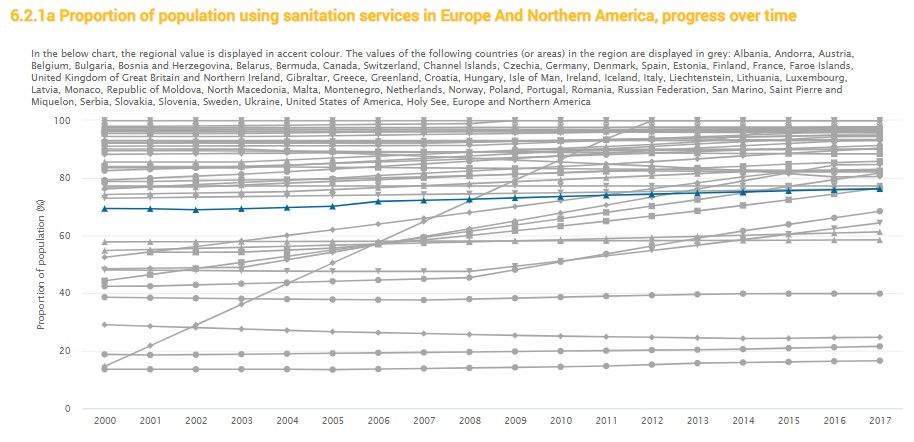
It is worth noting is that the degree of implementation of integrated water resources management in Europe and North America is 67%.
Water and Sanitation in Latin America and the Caribbean
The proportion of the population using drinking water services in Latin America and the Caribbean is 74%.
 In terms of the proportion of the population using sanitation services, the average figure is a worrisome 31%.
In terms of the proportion of the population using sanitation services, the average figure is a worrisome 31%.

In this region, the per cent of the population that rely on poor sanitation services or that practice open defecation stands out. In rural areas, it is 9%.

In addition, the proportion of the population with handwashing facilities with soap and water at home in Latin America and the Caribbean, by service level and by location, is as follows:

Cooperation has an important role in achieving SDG 6 in Latin America and the Caribbean, where the amount of water- and sanitation-related official development assistance received by the different countries amounts to a total of 691 million dollars. Here we should highlight the work of the Spanish Agency for International Development Cooperation (AECID) through the Water and Sanitation Cooperation Fund (FCAS), which implements programmes on institutional capacity building, promotion of water and sanitation services, and community development in 18 countries of Latin America and the Caribbean.
Water and sanitation in northern Africa and western Asia
The countries included in this region are United Arab Emirates, Armenia, Azerbaijan, Bahrain, Cyprus, Algeria, Egypt, Western Sahara, Georgia, Iraq, Israel, Jordan, Kuwait, Lebanon, Libya, Morocco, Oman, Qatar, Saudi Arabia, Sudan, Syrian Arab Republic, Tunisia, Turkey, Yemen and the State of Palestine.
Although there is no average figure for the population that use drinking water services in northern Africa and western Asia, more than 80% of the population has access to basic services.

In terms of the proportion of the population using sanitation services, the average is 38%, whereas 77% of the population of northern Africa and western Asia have access to a basic handwashing facility.

Water and sanitation in Sub-Saharan Africa
The countries included in this region are Angola, Burundi, Benin, Burkina Faso, Botswana, Central African Republic, Côte d'Ivoire, Cameroon, Democratic Republic of the Congo, Congo, Comoros, Cabo Verde, Djibouti, Eritrea, Ethiopia, Gabon, Ghana, Guinea, Gambia, Guinea-Bissau, Equatorial Guinea, Kenya, Liberia, Lesotho, Madagascar, Mali, Mozambique, Mauritania, Mauritius, Malawi, Mayotte, Namibia, Niger, Nigeria, Réunion, Rwanda, Senegal, Saint Helena, Sierra Leone, Somalia, South Sudan, Sao Tome and Principe, Eswatini, Seychelles, Chad, Togo, United Republic of Tanzania, Uganda, South Africa, Zambia and Zimbabwe.
The proportion of the population using drinking water services in Sub-Saharan Africa is only 27 %. Réunion, Saint Helena and Mayotte have much higher proportion of the population with access to drinking water services than the remaining countries.
 In this region, we may note the per cent of the population (specially in rural areas) drinking water from an improved source, where the collection time is more than 30 minutes for a round trip, or directly it is not a safe source.
In this region, we may note the per cent of the population (specially in rural areas) drinking water from an improved source, where the collection time is more than 30 minutes for a round trip, or directly it is not a safe source.

In terms of the proportion of the population using sanitation services, the average figure is only 18 %, and such services are in general quite poor.


On the other hand, 25% of the population in Sub-Saharan Africa has access to basic handwashing services.

Water and sanitation in central and southern Asia
The countries included in this region are Afghanistan, Bangladesh, Bhutan, India, Iran (Islamic Republic of), Kazakhstan, Kyrgyzstan, Sri Lanka, Maldives, Nepal, Pakistan, Tajikistan, Turkmenistan and Uzbekistan.
The proportion of the population that use drinking water services in central and southern Asia is 60%; a particularly high proportion of the population has to these services in Turkmenistan, Iran and Kazakhstan.

In this region there are no data on the proportion of the population using sanitation services over time, but there are data from 2017, where we can observe that 29% of the rural population still practices open defecation.
 In terms of the proportion of the population with basic handwashing facilities in central and southern Asia, it amounts to 58%.
In terms of the proportion of the population with basic handwashing facilities in central and southern Asia, it amounts to 58%.

Water and sanitation in eastern and south-eastern Asia
The countries included in this region are Brunei Darussalam, China, China, Hong Kong Special Administrative Region, Indonesia, Japan, Cambodia, Republic of Korea, Lao People's Democratic Republic, China, Macao Special Administrative Region, Myanmar, Mongolia, Malaysia, Philippines, Democratic People's Republic of Korea, Singapore, Thailand, Timor-Leste and Viet Nam.
Although there is no average number for the population using drinking water services in eastern and south-eastern Asia, the proportion of the population with basic and safe services in 2017 was considered very high.

In this region, the proportion of the population using sanitation services is 64%, with Singapore and Japan being the countries with the highest proportion.

Water and sanitation in Australia and New Zealand
In this region, the proportion of the population using drinking water services is very high; nobody has limited access.

Regarding sanitation, the proportion of the population using these services is 72%.
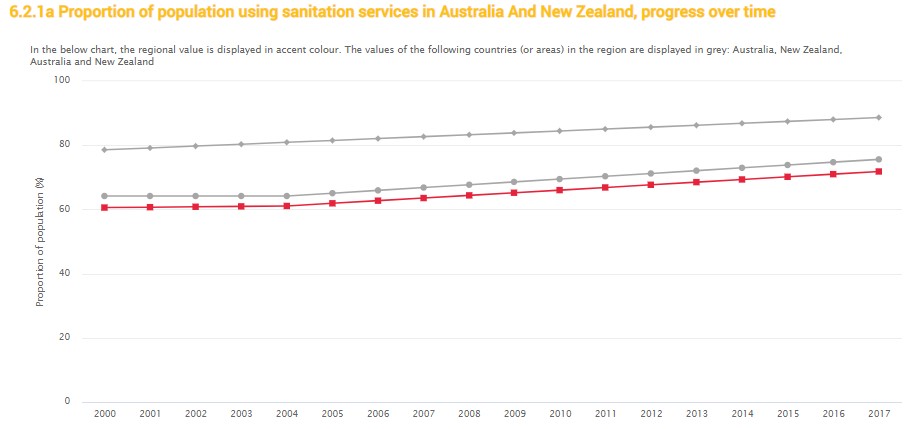
You can find the data tracking progress toward Sustainable Development Objective 6 here.



